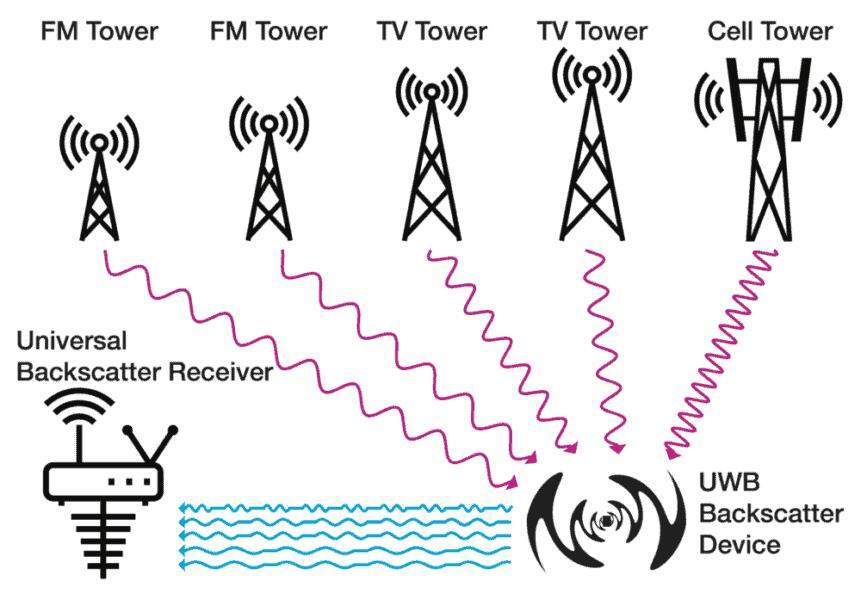Internet of things (IoT) systems usually link networks of sensors via radio, but radios demand battery power thus limiting usability. Disney Research has determined that one solution may be to get rid of the radios all together and communicate via the ambient radio waves from TV, radio and cell phones.
Researchers led by Alanson Sample, associate lab director and leader of Disney Research’s Wireless Systems group, devised an ultra-low-power system of sensors that transmit data to a central receiver by reflecting the ambient radio waves from commercial broadcasting systems that already bathe most office environments.
“Our idea is to reuse all the radio signals that are around us as a medium for transmitting data, much like sending ripples across a pond,” Sample said.
This approach radically reduces the power requirements of the sensor nodes because it is the generation of radio waves that consumes most of their battery power. In a demonstration in a Disney Research lab, the researchers were able to meet the tiny bit of power demand that remained by using solar cells optimized for low-light conditions.
The researchers presented details of their ultra-wideband (UWB) ambient backscatter system at the IEEE Conference on Computer Communication, INFOCOM 2017, in Atlanta, Ga. The research team, which included Chouchang Yang and Jeremy Gummeson, demonstrated the system in an indoor office environment, using ambient signals from 14 radio towers as well as two mobile phones.
“The promise of the Internet of Things is that wireless sensors will be ubiquitous, allowing devices to sense their environments and talk to each other,” said Markus Gross, vice president at Disney Research. “As we move towards connecting the next billion wireless devices to the internet, however, the use of batteries to power these devices will become unworkable. UWB ambient backscatter systems, which potentially could be deployed in any metropolitan area, hold great potential for solving this dilemma.”
Backscatter communication already is used in passive RFID tags. In that case, an RFID reader transmits radiofrequency power to the battery-free RFID tag; the tag sends data to the reader by reflecting, or backscattering, the carrier wave back to the reader. These systems have limited range, which makes them impractical for IoT systems.
Other researchers have shown systems that require even less power by using ambient radio waves from a single source, such as a TV station. But, again, the range is limited to a few meters unless the power of the ambient signals is boosted to high levels.
Sample said the UWB approach – which backscatters all ambient sources – offers key advantages. Using multiple backscatter channels boosts the signal-to-noise ratio, substantially improving the sensitivity of the backscatter reader and decreasing dead zones. That, in turn, enables the system to operate on real-world ambient sources and substantially extends the range – to 22 meters when using ambient signals from broadcast towers and 50 meters when using ambient signals generated by mobile phone up-link traffic.
The ultra-low-power sensor nodes are necessarily simple, Sample said, which requires the backscatter reader to do the heavy lifting for the system. The reader must receive the backscatter signals, decode and combine multiple backscatter carriers to recover the data from each sensor. The reader uses four software-defined radio receivers — one for the FM radio band, another to cover most of the cellular uplink and downlink bands and two for digital TV bands.
Because the hardware doesn’t have to be tuned to any particular frequency band, the UWB system can be deployed in almost any metropolitan area, he added. Unlike other experimental systems that leverage ambient radio waves, the Disney system doesn’t focus on a single signal source, but uses all available ambient radio sources, from FM radio broadcasts to digital TV signals to the transmissions to and from cellular phones.
Combining creativity and innovation, this research continues Disney’s rich legacy of leveraging technology to enhance the tools and systems of tomorrow.
If our reporting has informed or inspired you, please consider making a donation. Every contribution, no matter the size, empowers us to continue delivering accurate, engaging, and trustworthy science and medical news. Independent journalism requires time, effort, and resources—your support ensures we can keep uncovering the stories that matter most to you.
Join us in making knowledge accessible and impactful. Thank you for standing with us!

